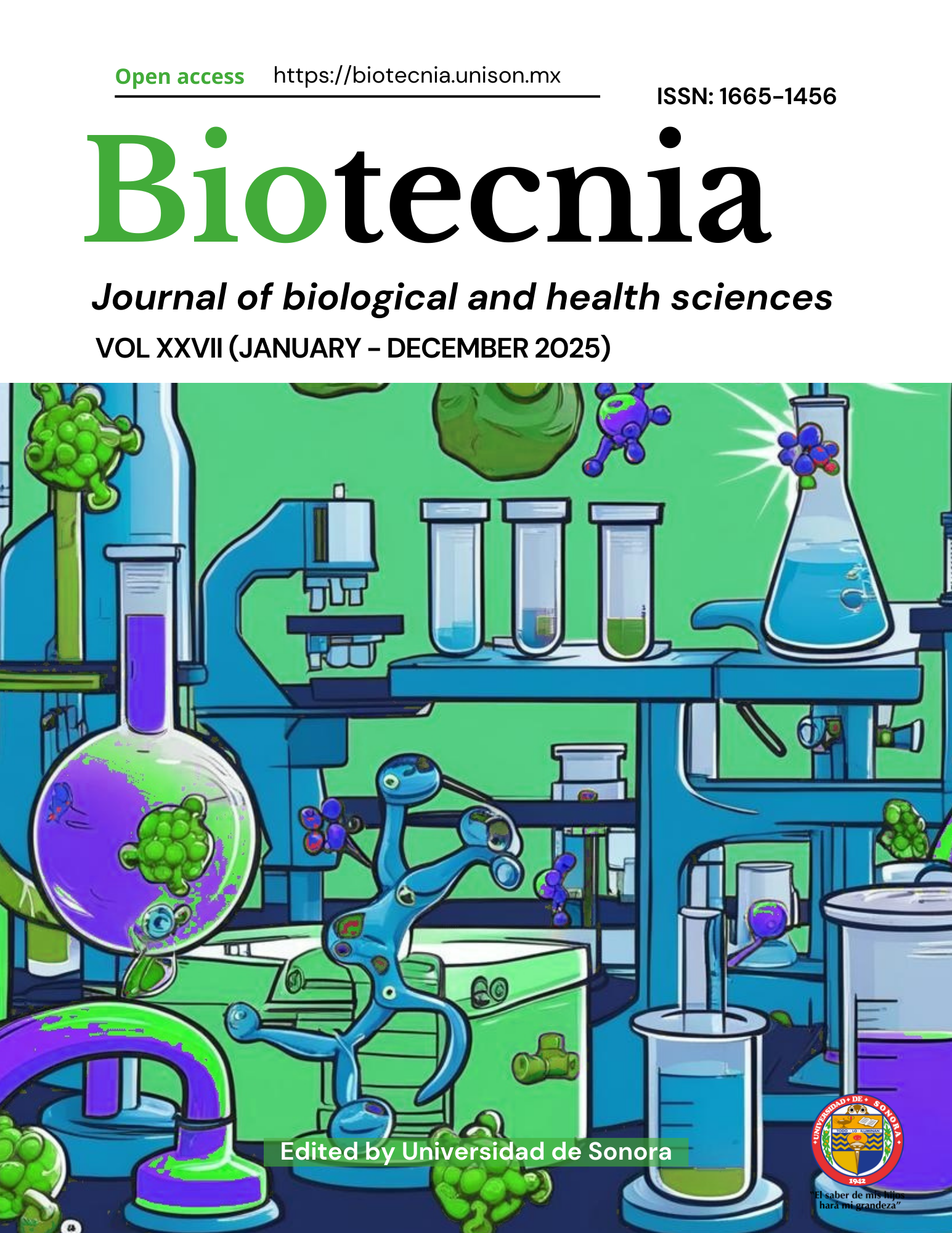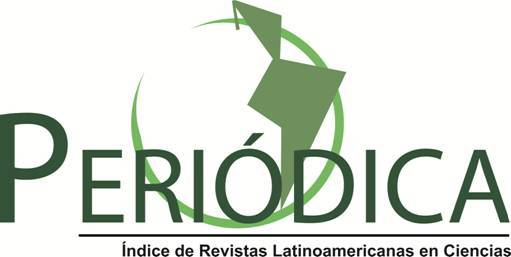Simultaneous degradation of phenolic compounds under denitrifying conditions in a UASB reactor provided with granular activated carbon
DOI:
https://doi.org/10.18633/biotecnia.v27.2452Keywords:
Phenolic compounds, Adsorption isotherms, UASB reactor, Activated carbonAbstract
This work studied the removal capacity of a mixture of phenolic compounds (phenol, p-cresol, o-cresol) by denitrification; in addition, the effect of granular activated carbon (GAC) in the process carried out in UASB (up-flow anaerobic sludge blanket) reactors. The organic load was increased from 450 to 3250 mg C L-1d-1 by adjusting the HRT from 2 to 0.25 d in the reactor with GAC and the control reactor without GAC. The removal efficiencies of phenolic compounds increased as the organic load increased, obtaining values from 89.7 % to 95.5 % in the reactor without GAC and 95.8 % to 99.1 % in the reactor with GAC. The nitrate removal in the reactor with GAC reached 79.3 % to 98.0 % efficiencies, while the control obtained 64.8 % to 96.9 %. Finally, the maximum capacities of GAC were evaluated by adsorption isotherms, obtaining the following values (mg g-1): 164.6 for o-cresol, 134.5 for p-cresol, 110.7 for phenol, and 44.4 for nitrate. The results show the capacity of a denitrification process to remove a mixture of phenolic compounds. In addition, the reactor with GAC increased the removal efficiency of all compounds.
Downloads
References
Ahalya, N., Kanamadi, R. D., & Ramachandra, T. V. (2006) Biosorption of iron (III) from aqueous solutions using the husk of Cicer arientinum. Indian Journal of Chemical Technology 13: 122-127. http://nopr.niscpr.res.in/handle/123456789/7010
Annadurai, G., Juang, R. S., & Lee, D. J. (2002). Biodegradation and adsorption of phenol using activated carbon immobilized with Pseudomonas putida. Journal of Environmental Science and Health, Part A, 37(6), 1133-1146.
Al-Degs Y, Khraisheh MAM, Allen SJ, Ahmad MN (2000) Effect of carbon chemistry on the removal of reactived dyes from textile effluent. Water Res 34(3): 927-935
APHA (1985) Standard methods for examination of water and wastewater. American Public Health Association, Washington, D. C.
Beristain-Cardoso, R., Texier, A. C., Sierra-Álvarez, R., Razo-Flores, E., Field, J. A., & Gomez, J. (2009). Effect of initial sulfide concentration on sulfide and phenol oxidation under denitrifying conditions. Chemosphere, 74(2), 200-205. https://doi.org/10.1016/j.chemosphere.2008.09.066
Blanco-Martínez DA, Giraldo L, Moreno-Piraján JC (2009) Effect of the pH in the adsorption and in the immersion enthalpy of monohydroxylated phenols from aqueous solutions on activated carbons. J Hazard Mater 169:291-296
Cervantes FJ, Meza-Escalante ER, Texier AC, Gómez J (2009) Kinetic limitations during the simultaneous removal of p-cresol and sulfide in a denitrifying process. Journal of Industrial Microbiology and Biotechnology 36(11), 1417.https://doi.org/10.1007/s10295-009-0628-6
Dąbrowsky A, Podkościelny P, Hubicki Z, Barczak M (2005) Adsorption of phenolic compounds by activated carbon—a critical review. Chemosphere 58:1049-1070
Feng L, Han Y, Niu J, Guo J, Zhang J, Li H, Hou Y, Song Y (2023) Synergistic removal performance and mechanism in denitrification system under phenol stress, Journal of Environmental Chemical Engineering 11 (5): 110767. https://doi.org/10.1016/j.jece.2023.110767
Fu, L., Li, J., Wang, G., Luan, Y., & Dai, W. (2021). Adsorption behavior of organic pollutants on microplastics. Ecotoxicology and Environmental Safety, 217, 112207. https://doi.org/10.1016/j.ecoenv.2021.112207
Ge, C. H., Sun, N., Kang, Q., Ren, L. F., Ahmad, H. A., Ni, S. Q., & Wang, Z. (2018). Bacterial community evolutions driven by organic matter and powder activated carbon in simultaneous anammox and denitrification (SAD) process. Bioresource Technology, 251, 13-21.
González-Blanco, G., Beristain-Cardoso, R., Cuervo-López, F., Cervantes, F. J., & Gómez, J. (2012). Simultaneous oxidation of ammonium and p-cresol linked to nitrite reduction by denitrifying sludge. Bioresource Technology, 103(1), 48-55. https://doi.org/10.1016/j.biortech.2011.09.086
González‐Blanco G, Cuervo‐López F, Cervantes FJ, Beristain‐Cardoso R, Gómez J (2013). Nitrite as oxidizing power for p‐cresol removal using a denitrifying sludge: kinetic study. Journal of Chemical Technology & Biotechnology, 88(12), 2176-2180. https://doi.org/10.1002/jctb.4082
Hamdaoui O, Naffrechoux E (2007) Modeling of adsorption isotherms of phenol and chlorophenols onto granular activated carbon Part I. Two-parameter models and equations allowing determination of thermodynamic parameters. J Hazard Mater 147:381-394
Juang, R. S., Wu, F. C., & Tseng, R. L. (1996). Adsorption isotherms of phenolic compounds from aqueous solutions onto activated carbon fibers. Journal of Chemical & Engineering Data, 41(3), 487-492. https://doi.org/10.1021/je950238g
Jung MW, Ahn KH, Lee Y, Kim KP, Rhee JS, Park JT, Paeng KJ (2001) Adsorption characteristics of phenol and chlorophenols on granular activated carbons (GAC). Microchem J, 70(2):123-131
Li, M., Xiao, J., Zeng, Z., Zhang, T., & Ren, Y. (2023). Study on the biodegradation of phenol by Alcaligenes faecalis JH1 immobilized in rice husk biochar. Frontiers in Environmental Science, 11, 1294791.
Li, H., Wang, F., Li, J., Deng, S., & Zhang, S. (2021). Adsorption of three pesticides on polyethylene microplastics in aqueous solutions: Kinetics, isotherms, thermodynamics, and molecular dynamics simulation. Chemosphere, 264, 128556. https://doi.org/10.1016/j.chemosphere.2020.128556
Lin SH, Juang RS (2009) Adsorption of phenol and its derivates from water using synthetic resins and low-cost natural adsorbents: A review. J of Environ Manage, 90:1336-1349
Liu C., Han K., Lee DJ, Wang O (2016) Simultaneous biological removal of phenol, sulfide, and nitrate using expanded granular sludge bed reactor, Appl Microbiol Biotechnol 100, 4211–4217 https://doi.org/10.1007/s00253-016-7293-2
Liu L, Tan SJ, Horikawa T, Do DD, Nicholson D, Liu J (2017). Water adsorption on carbon-A review. Advances in colloid and interface science, 250: 64-78. https://doi.org/10.1016/j.cis.2017.10.002.
Mahdavianpour M, Moussavi G, Farrokhi M (2018). Biodegradation and COD removal of p -Cresol in a denitrification baffled reactor: Performance evaluation and microbial community. Process Biochemistry, 69, 153–160. doi:10.1016/j.procbio.2018.03.01
Martínez S, Cuervo-López FM, Gomez J (2007) Toluene mineralization by denitrification in an up flow anaerobic sludge blanket (UASB) reactor, Bioresource Technology, 98(9) 1717-1723 https://doi.org/10.1016/j.biortech.2006.07.046
Meza-Escalante ER, Texier AC, Cuervo-López F, Gómez J, Cervantes FJ (2008) Inhibition of sulphide on the simultaneous removal of nitrate and p-cresol by denitrifying sludge. J Chem Technol Biotechnol 83:372-377
Monroy, M. (2010). Carbones activados con actividad biológica: Aplicación en la degradación de compuestos fenólicos procedentes de aguas residuales de la industria metalúrgica de Nobsa-Boyacá Manuel. Universidad Nacional de Colombia Facultad de Ciencias Posgrado Ciencias-Microbiología, 89. https://repositorio.unal.edu.co/handle/unal/11280
Moreno C, Rivera-Utrilla J, López-Ramón MV, Carrasco-Marín F (1995) Adsorption of some substituted phenols on activated carbons from a bituminous coal. Carbon 33(6): 845-851
Nouri S, Haghseresht F, Max Lu GQ (2002a) Comparison of adsorption capacity of p-cresol and p-nitrophenol by activated carbon in single and double solute. Adsorption 8(3):215-223. doi:10.1023/a:1021260501001
Nouri, S., Haghseresht, F., & Lu, M. (2002b). Adsorption of aromatic compounds by activated carbon: effects of functional groups and molecular size. Adsorption Science & Technology, 20(1), 1-15.
Peña-Calva A, Olmos-Dichara A, Viniegra-González G, Cuervo-López FM, Gómez J (2004) Denitrification in presence of benzene, toluene and m-xilene: kinetics, mass balance and yields. Appl Biochem Biotechnol 119: 195-208
Reyes-Avila J, Razo-Flores E, Gómez J (2004) Simultaneous removal of nitrogen, carbon and sulfur by denitrification. Water Res 38:3313-3321
Ribeiro R, de Nardi IR, Fernandes BS, Foresti E, Zaiat M (2013) BTEX removal in a horizontal-flow anaerobic immobilized biomass reactor under denitrifying conditions. Biodegradation 24, 269–278. https://doi.org/10.1007/s10532-012-9585-2
Riser-Roberts, E. 1992. Bioremediation of Petroleum contamined sites. CRC press. United States Of America. review. Enzyme Microbial. Technology. 14: 170-183.
Sierra-Alvarez R, Guerrero F, Rowlete P, Freeman S, Field JA (2005) Comparison of chemo-, hetero- and mixotrophic denitrification in laboratory-scale UASBs. Water Sci Technol 52:337-342.
Singh, N., Agarwal, B., & Balomajumder, C. (2016). Simultaneous treatment of phenol and cyanide containing aqueous solution by adsorption, biotreatment and simultaneous adsorption and biotreatment (SAB) process. Journal of Environmental Chemical Engineering, 4(1), 564–575. doi:10.1016/j.jece.2015.11.041
Downloads
Published
How to Cite
Issue
Section
License
Copyright (c) 2025

This work is licensed under a Creative Commons Attribution-NonCommercial-ShareAlike 4.0 International License.
The journal Biotecnia is licensed under the Attribution-NonCommercial-ShareAlike 4.0 International (CC BY-NC-SA 4.0) license.

















_(2).jpg)







